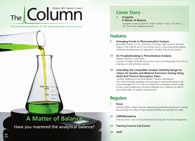Analyzing PSTs in Shellfish Aquaculture
Paralytic shellfish toxins (PSTs) are naturally occurring toxins produced by some species of microscopic algae that can accumulate in filter feeding shellfish. These toxins are a threat to shellfish aquaculture and pose a serious hazard to public health when ingested. A group of scientists has developed a method using hydrophilic interaction liquid chromatography coupled to ultrahigh?performance LC tandem mass spectrometry (HILIC UHPLC–MS–MS) to determine PSTs in a variety of shellfish species as part of the Safe New Zealand Seafood Research programme.

Photo Credit: Scott Halistone/Getty Images
Paralytic shellfish toxins (PSTs) are naturally occurring toxins produced by some species of microscopic algae that can accumulate in filter feeding shellfish. These toxins are a threat to shellfish aquaculture and pose a serious hazard to public health when ingested. A group of scientists has developed a method using hydrophilic interaction liquid chromatography coupled to ultrahighâperformance LC tandem mass spectrometry (HILIC UHPLC–MS–MS) to determine PSTs in a variety of shellfish species as part of the Safe New Zealand Seafood Research programme.1
Historically, shellfish toxins have been analyzed using mouse bioassay methods, but over recent years alternatives have been sought for ethical and technical reasons. Corresponding author Michael J. Boundy told The Column: “In 2001, the Cawthron Institute (New Zealand) began implementing routine monitoring of the lipophilic shellfish toxins using high performance liquid chromatography (HPLC)–mass spectrometry. For many years, these lipophilic shellfish toxins were routinely monitored by LC–MS with export clearance required to be combined with a mouse bioassay screen whereas paralytic shellfish toxins were determined solely by mouse bioassay.” He said: “At the time, the only available official method of analysis was the AOAC 2005.06 preâcolumn oxidation LC fluorescence (FL) method, which was decided to be a suitable interim method for regulatory monitoring in New Zealand. Appraisal of more recent official methods of analysis AOAC 2011.02 (postâcolumn oxidation LC-FL) and AOAC 2001.27 (receptor binding assay) indicated that none of the methods of analysis met all of our laboratories requirements for both regulatory monitoring and research projects (fast analysis, short turn-around-time, high throughput, sensitive, quantitation of toxin profile, low cost). Therefore, we sought to develop a new method that would meet our requirements.”
PSTs are a broad range of small, structurally very similar compounds that have a wide range of toxicities meaning that mass spectrometry analyses can be challenging, but HILIC separation was initially shown to be very promising. However, it was evident very early on in the research that chromatographic reproducibility was poor. Boundy told The Column: “Most of the effort spent in the development of the method was developing a set of mobile phases and chromatographic conditions that could be easily and consistently prepared, and would allow robust chromatography that would meet the requirements of a routine testing lab.”
There were significant problems when identifying and quantifying toxins in shellfish using HILIC that were caused by the high concentrations of salt solutions found in the marine environment. Boundy said: “In the presence of high concentrations of salt solutions, retention on the analytical column is significantly impacted, and retention times would greatly differ between standards and samples. Due to the wide range of compounds sharing mass-spectrometric MRM transitions, mitigating this retention shift in samples was very important to ensure specificity and correct identification of the compounds of interest.”
To overcome this issue, sample clean-up was therefore necessary. The study authors chose graphitized carbon for this purpose as it had been previously shown to be successful in retaining highly polar compounds. Samples were then analyzed using a rapid, selective, and sensitive HILIC UHPLC–MS–MS method for identification of PSTs in shellfish. A validation study on 12 commercially produced shellfish species has been performed and will be published shortly. Michael concluded: “The improved sensitivity and specificity of the developed HILIC UHPLC–MS–MS method over the previous methods of analysis has been extremely beneficial with a range of research projects. The improved sensitivity will provide industry with an earlier warning during a harmful algal bloom, and the improved turnâaround time will reduce the delays before harvested product can be sold.” - K.M.
Reference
1. M.J. Boundy, Andrew I. Selwood, D.T. Harwood, et al., Journal of Chromatography A 1387, 1–12 (2015).
This news story was published in LCGC's digital magazine, The Column. Click here to view the issue>>

Polysorbate Quantification and Degradation Analysis via LC and Charged Aerosol Detection
April 9th 2025Scientists from ThermoFisher Scientific published a review article in the Journal of Chromatography A that provided an overview of HPLC analysis using charged aerosol detection can help with polysorbate quantification.
Analyzing Vitamin K1 Levels in Vegetables Eaten by Warfarin Patients Using HPLC UV–vis
April 9th 2025Research conducted by the Universitas Padjadjaran (Sumedang, Indonesia) focused on the measurement of vitamin K1 in various vegetables (specifically lettuce, cabbage, napa cabbage, and spinach) that were ingested by patients using warfarin. High performance liquid chromatography (HPLC) equipped with an ultraviolet detector set at 245 nm was used as the analytical technique.












